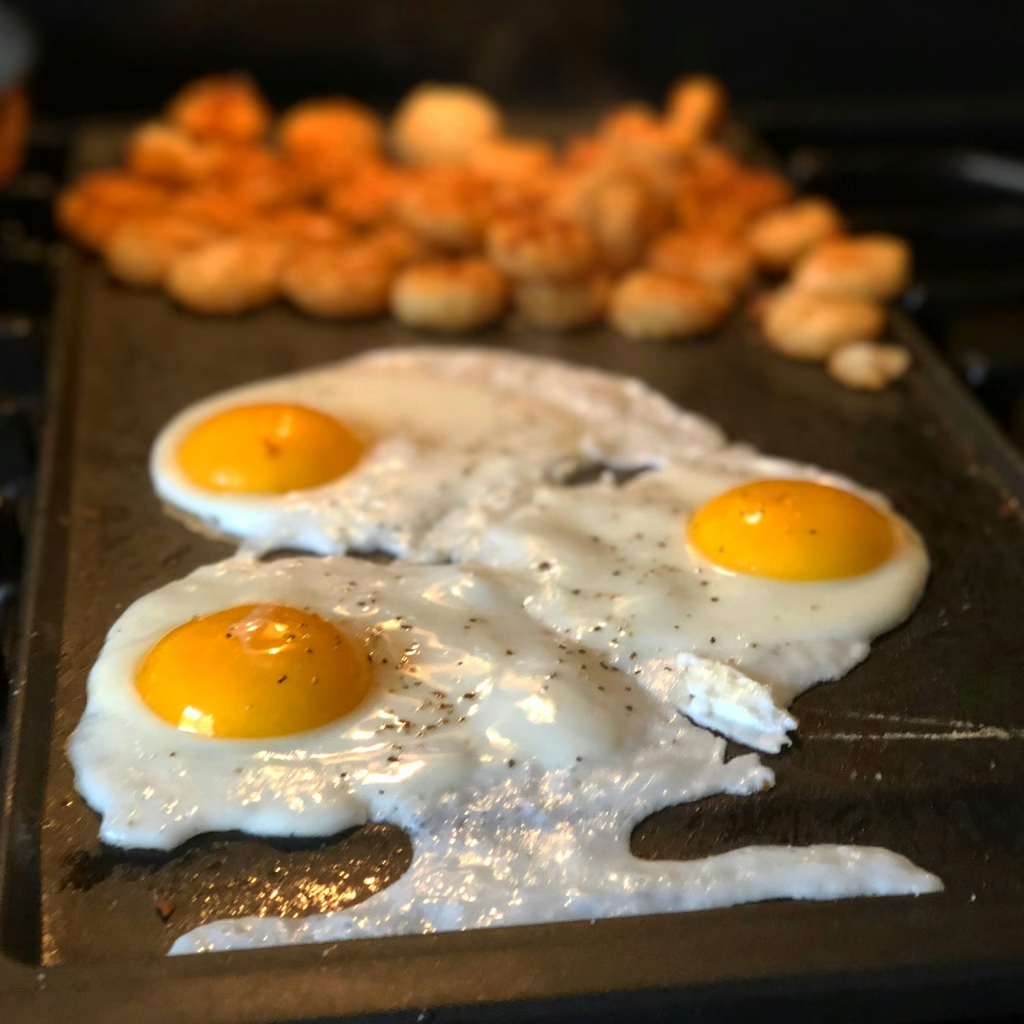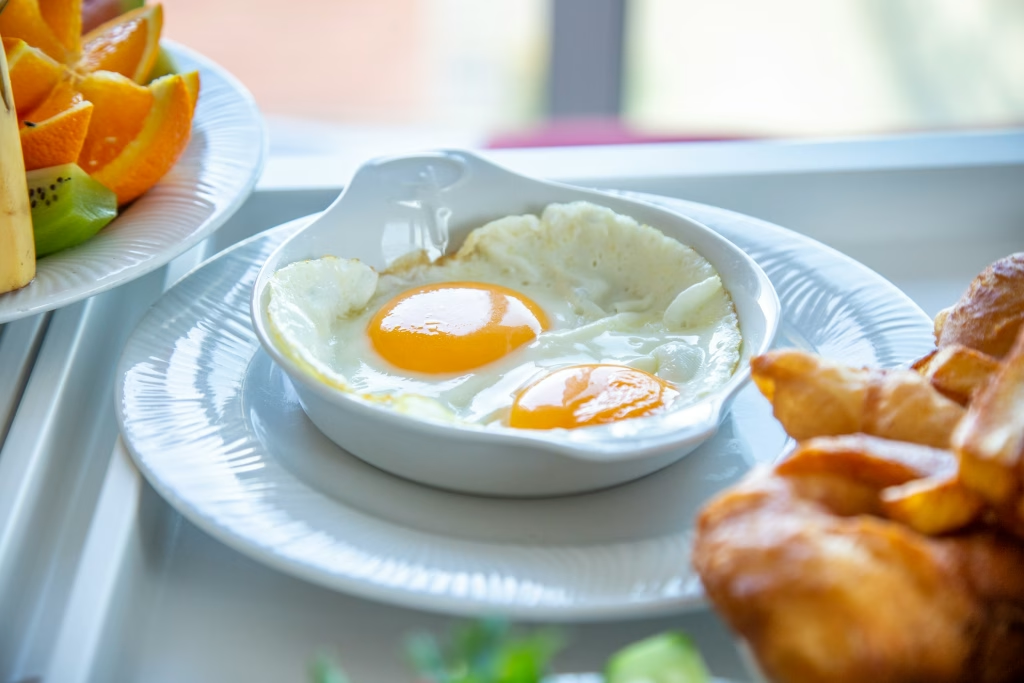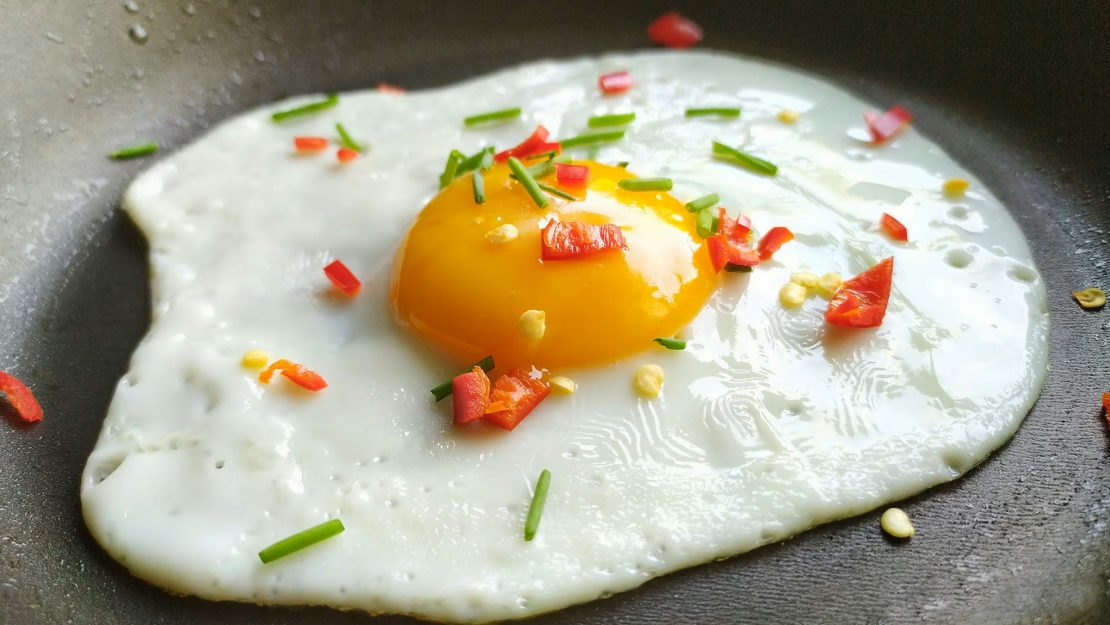Looking for a simple and delicious breakfast idea that will kick-start your day? Look no further!
Our fried eggs recipe is a quick and easy solution that will satisfy your taste buds and provide you with a nutritious start.
Whether you’re cooking for yourself or a small group, this recipe serves 2 people and takes just 10 minutes to prepare.
Get ready to enjoy perfectly cooked fried eggs with a golden, crispy edge and a tender, runny yolk. Let’s dive into the details!
Table of Contents
Ingredients:
- 4 large eggs
- 2 tablespoons of butter
- Salt and pepper to taste
- Optional toppings: grated cheese, chopped herbs (parsley, chives, or basil)
Serves: 2 people
Estimated Time: 10 minutes
Step-by-Step Preparation:
Step 1:
Heat the Pan: Place a non-stick frying pan or skillet over medium heat. Allow it to warm up for a minute or two.
Step 2:
Add Butter: Add the butter to the pan and let it melt completely. Swirl the pan to coat the surface evenly with the melted butter.
Step 3:
Crack the Eggs: Carefully crack the eggs one at a time into a small bowl or directly into the pan, ensuring you don’t break the yolks.
Step 4:
Season with Salt and Pepper: Sprinkle salt and pepper over the eggs according to your taste preferences. You can always adjust the seasoning later.
Step 5:
Fry the Eggs: Allow the eggs to cook undisturbed for about 2 minutes until the whites are set but the yolks are still runny. If you prefer a fully cooked yolk, cook for an additional minute.
Step 6:
Flip or Cover (Optional): If desired, you can gently flip the eggs using a spatula for an over-easy or over-medium style.
Alternatively, cover the pan with a lid for a few seconds to slightly cook the top part of the eggs while keeping the yolks runny.
Step 7:
Serve: Carefully transfer the fried eggs to a plate using a spatula. Sprinkle grated cheese or chopped herbs on top for added flavor and presentation.

Nutritional Facts:
- Calories per serving: Approximately 144
- Total Fat: 10g
- Saturated Fat: 5g
- Cholesterol: 372mg
- Sodium: 240mg
- Protein: 13g
Tips and Tricks
- Use fresh eggs for the best taste and texture.
- Experiment with different oils or flavored butters for a unique twist.
- Add a lid to the pan to steam the eggs slightly for a different texture.
Common Mistakes to Avoid
- Cooking eggs on high heat can result in rubbery textures.
- Cracking eggs directly into the pan increases the risk of shell fragments.
Health Benefits
Fried eggs are a good source of protein, essential vitamins, and minerals. They contribute to a balanced and nutritious breakfast.
Serving Suggestions
Pair your fried eggs with toast, avocado, or a side of fresh fruit for a well-rounded breakfast.
Variations
Explore variations like poached eggs, scrambled eggs with different mix-ins, or incorporate international flavors for a culinary adventure.
History of Fried Eggs
- Ancient Origins: Fried eggs have a rich history, with evidence suggesting their consumption dates back to ancient civilizations.
- Medieval Europe: In medieval Europe, eggs were often fried or cooked in various ways, becoming a staple in breakfast cuisine.
- Colonial America: Early American settlers continued the tradition of frying eggs, adapting the practice to locally available ingredients.
- 19th Century Innovations: The 19th century saw innovations in cooking techniques, and fried eggs became more commonly featured in cookbooks.
- Industrial Revolution Impact: The Industrial Revolution brought about changes in cooking methods, making fried eggs more accessible to a broader population.
- World Wars Influence: The simplicity and affordability of fried eggs made them a popular choice during times of rationing, such as World Wars I and II.
- Post-War Boom: In the post-war era, fried eggs retained their popularity, becoming a symbol of a hearty and economical meal.
- Culinary Evolution: Over the years, fried eggs evolved, with various cultures incorporating unique flavors and toppings to create diverse regional variations.
- Health and Nutrition: Fried eggs gained recognition for their nutritional value, providing protein and essential nutrients, contributing to their enduring popularity.
- Modern Culinary Landscape: Today, fried eggs remain a versatile and beloved dish worldwide, enjoyed for breakfast or as a quick and satisfying meal any time of the day.

In just 10 minutes, you can prepare a scrumptious breakfast with our easy fried eggs recipe.
With minimal ingredients and simple steps, you’ll have a delicious and nutritious meal to enjoy.
Remember to personalize your eggs with optional toppings like grated cheese or herbs to add an extra touch of flavor.
Start your day off right with this delightful and satisfying breakfast option!
Remember, experimenting with different seasonings and additional ingredients can create exciting variations of this classic recipe.
Enjoy your perfectly cooked fried eggs and make every breakfast a memorable one!
Frequently Asked Questions (FAQs)
Q1: Can I use olive oil for frying eggs?
A1: Absolutely! Olive oil adds a distinct flavor to your fried eggs.
Q2: How can I achieve a perfect sunny-side-up egg?
A2: Cook the eggs on low heat without flipping until the whites are set but the yolk remains runny.
Q3: Can I prepare fried eggs in advance?
A3: It’s best to cook fried eggs fresh for optimal taste and texture.
Q4: What is the ideal pan for frying eggs?
A4: A non-stick frying pan is ideal for easy flipping and cleaning.
Q5: How do I prevent the yolks from breaking during cooking?
A5: Crack the eggs into a separate bowl before adding them to the pan to avoid broken yolks.


